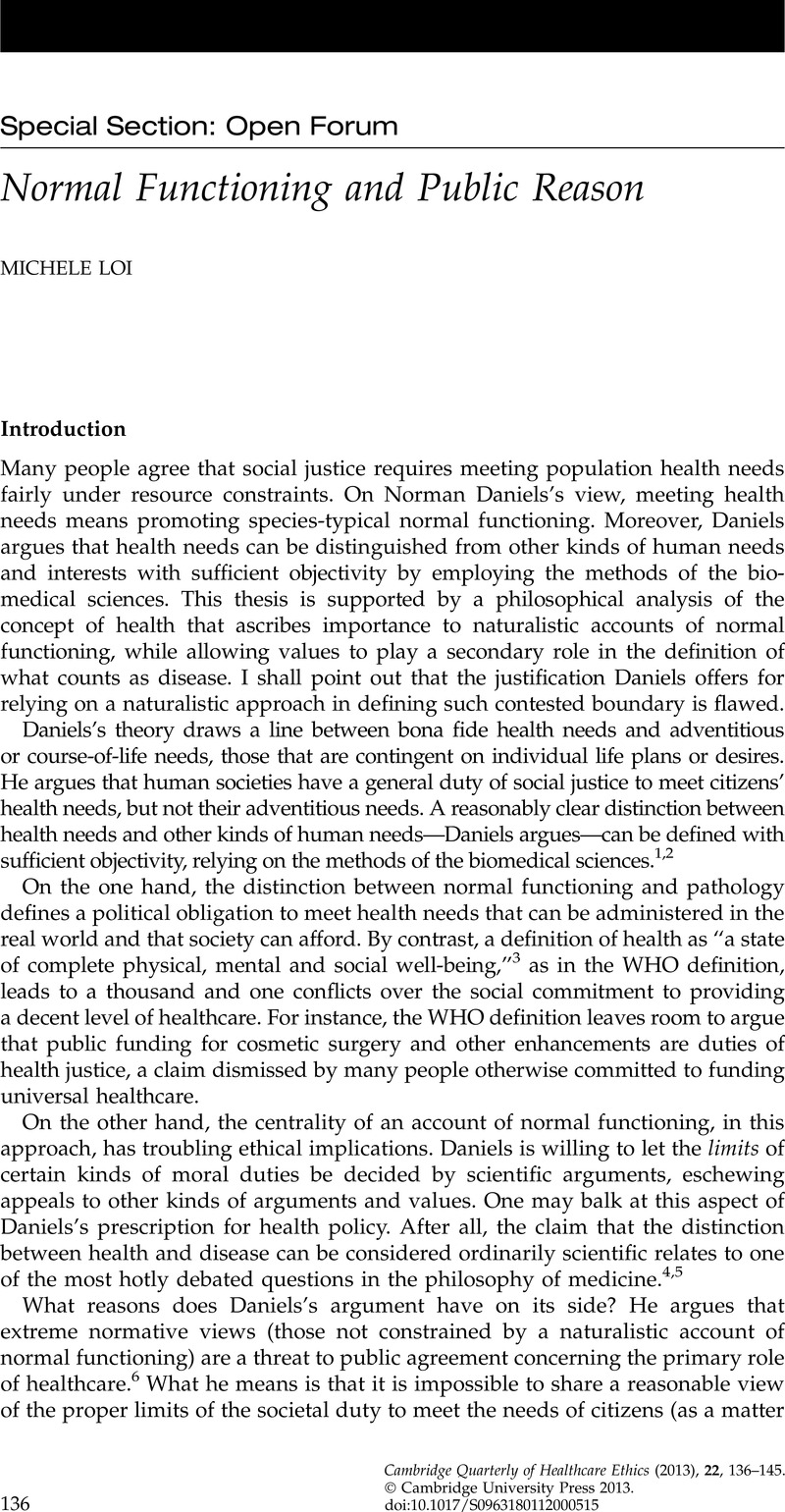No CrossRef data available.
Article contents
Normal Functioning and Public Reason
Published online by Cambridge University Press: 14 March 2013
Abstract

- Type
- Special Section: Open Forum
- Information
- Copyright
- Copyright © Cambridge University Press 2013
References
Notes
1 Daniels N. Just Health: Meeting Health Needs Fairly. Cambridge: Cambridge University Press; 2008, at 37.
2 Daniels N. Normal functioning and the treatment-enhancement distinction. Cambridge Quarterly of Healthcare Ethics 2000;9:309–22, at 315.
3 World Health Organization. Preamble to the Constitution of the World Health Organization as adopted by the International Health Conference, New York, 19–22 June 1946; signed on 22 July 1946 by the representatives of 61 states (Official Records of the World Health Organization, no. 2, p. 100) and entered into force on 7 April 1948; 1946; available at http://www.who.int/about/definition/en/print.html(last accessed 24 June 2009).
4 Nordenfelt L. Health, Science, and Ordinary Language. Amsterdam: Rodopi; 2001.
5 Engelhardt HT. The Foundations of Bioethics. New York: Oxford University Press; 1986.
6 See note 1, Daniels 2008, at 40.
7 See note 1, Daniels 2008, at 40.
8 See note 1, Daniels 2008, at 42, especially the following: “the intuitive distinction underlying the biomedical view can be reformulated into a nonnormative (or naturalistic) distinction.”
9 Kingma E. What is it to be healthy? Analysis 2007;67(294):128–33.
10 Boorse C. On the distinction between disease and illness. Philosophy and Public Affairs 1975;5(1):49–68.
11 Boorse C. Health as a theoretical concept. Philosophy of Science 1977;44(4):542–73.
12 Boorse C. A rebuttal on health. Biomedical Ethics Reviews 1997:1–134.
13 Daniels N. Just Health Care. Cambridge: Cambridge University Press; 1985, at 28–30.
14 See note 1, Daniels 2008, at 38.
15 Wakefield J. The concept of mental disorder: On the boundary between biological facts and social values. The American Psychologist 1992;47(3):373–88, at 381–5.
16 See note 1, Daniels 2008, at 39.
17 See note 11, Boorse 1977, at 562.
18 See also note 12, Boorse 1997, at 7.
19 See note 11, Boorse 1977.
20 See note 9, Kingma 2007, at 130–1. More specifically, Kingma considers three possible interpretations of “a natural class of organism of uniform functional design,” namely, a class defined by (1) statistically common characteristics, (2) a high degree of uniformity among class members, and (3) natural design. The first interpretation is unacceptable because some age groups and morphological types (the queen design in the bee, for instance) have very few members. The second must be rejected because many diseases, especially genetic ones, can be remarkably uniform. The third appeals to either a theological or an evolutionary concept of design: the former renounces naturalism, whereas the latter does not fit our intuitions because some pathologies (e.g., sickle cell anemia) result from natural selection.
21 See note 9, Kingma 2007, at 131.
22 See note 10, Boorse 1975, at 63.
23 See note 9, Kingma 2007, at 132.
24 See note 10, Boorse 1975, at 61–2.
25 See also note 12, Boorse 1997, at 11.
26 See note 1, Daniels 2008, at 42.
27 Rawls J. Political Liberalism. Expanded ed. New York: Columbia University Press; 1996, at 54–7.
28 See note 1, Daniels 2008, at 40.
29 See note 1, Daniels 2008, at 42.
30 See note 1, Daniels 2008, at 42.
31 See note 27, Rawls 1996, at 223–30.
32 See note 1, Daniels 2008, at 40.
33 See note 1, Daniels 2008, at 40.
34 See note 1, Daniels 2008, at 40.
35 See note 1, Daniels 2008, at 40.




